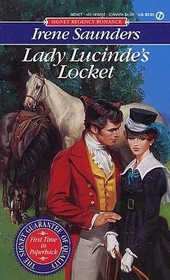Kathleen T. (keska) reviewed Lady Lucinde's Locket (Signet Regency Romance) on + 204 more book reviews
back cover:
THE UNLADYLIKE LADY
No proper young lady would have run away to wed a foolhardy youth like Henry Coldwell. No proper young lady would have survived early widowhood with enough nerve intact to prove herself as brave as a man in war. No proper young lady would have returned to England to take society by storm while breaking all its rules.
But Lady Lucinde Coldwell was no proper young lady. Which won her everything she wanted until she met the upright, arrogant, irresistibly attractive Lord Anthony Mortimer, who tolerated no impropriety in a lady - and turned Lucinde into a most desparately devious woman in love.
THE UNLADYLIKE LADY
No proper young lady would have run away to wed a foolhardy youth like Henry Coldwell. No proper young lady would have survived early widowhood with enough nerve intact to prove herself as brave as a man in war. No proper young lady would have returned to England to take society by storm while breaking all its rules.
But Lady Lucinde Coldwell was no proper young lady. Which won her everything she wanted until she met the upright, arrogant, irresistibly attractive Lord Anthony Mortimer, who tolerated no impropriety in a lady - and turned Lucinde into a most desparately devious woman in love.
Usually I trust Signet regencies, because in those days they had an excellent editor, Hilary Ross, handling their regency line, and the books were written to a higher level by authors and edited by staff familiar with the history and society of the regency era; they didn't just get it from watching Pride and Prejudice a couple of times. This book is an exception.
Saunders' hero is an earl. Family name is Anthony Mortimer. Title name is Earl of Grassington. He is serving in the army when he inherits, so he's Colonel Lord Grassington, or just Lord Grassington; he is *not* Colonel Anthony Mortimer. Later a butler introduces him as Lord Mortimer, Earl of Grassington. He is *not* Lord Mortimer, he's the Earl of Grassington. A properly trained butler, or even a footman reading from a visiting card, would *never* make a mistake like that.
During the regency era titles told you exactly who that person was and where they stood in society - their lifestyle, their responsibilities, everything. In a modern novel, that goes to character, and it's the one detail you cannot screw up in a regency because it indicates a lack of knowledge of how that society worked and how characters fitted into it. Plus it's sooo easy to check; even in pre-internet days, it wasn't hard to check out common, important forms of address.
Having found this massive gaffe in the first 33 pages, the whole novel was discredited for me. I didn't finish it.
Saunders' hero is an earl. Family name is Anthony Mortimer. Title name is Earl of Grassington. He is serving in the army when he inherits, so he's Colonel Lord Grassington, or just Lord Grassington; he is *not* Colonel Anthony Mortimer. Later a butler introduces him as Lord Mortimer, Earl of Grassington. He is *not* Lord Mortimer, he's the Earl of Grassington. A properly trained butler, or even a footman reading from a visiting card, would *never* make a mistake like that.
During the regency era titles told you exactly who that person was and where they stood in society - their lifestyle, their responsibilities, everything. In a modern novel, that goes to character, and it's the one detail you cannot screw up in a regency because it indicates a lack of knowledge of how that society worked and how characters fitted into it. Plus it's sooo easy to check; even in pre-internet days, it wasn't hard to check out common, important forms of address.
Having found this massive gaffe in the first 33 pages, the whole novel was discredited for me. I didn't finish it.




